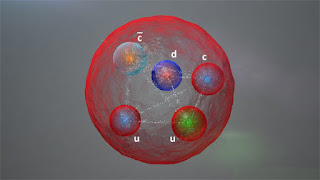And though I ...understand all mysteries, and all knowledge; ...and have not LOVE, I am nothing.
1 Corinthians 13:2
"Physicists from CERN’s Large Hadron Collider beauty (LHCb) Collaboration announced this week the discovery of a new pentaquark particle, Pc(4312)+, decaying to a proton and a J/ψ meson, a particle composed of a charm quark and a charm antiquark.
In the conventional quark model, strongly interacting particles known as the hadrons are formed either from quark-antiquark pairs (mesons) or three quarks (baryons). Particles which cannot be classified within this scheme are referred to as exotic hadrons.
In his fundamental 1964 paper, in which he proposed the quark model, the American physicist Murray Gell-Mann mentioned the possibility of adding a quark-antiquark pair to a minimal meson or baryon quark configuration.
It took 50 years, however, for scientists to obtain unambiguous experimental evidence of the existence of these exotic hadrons.
the LHCb Collaboration reported the Pc(4450)+ and Pc(4380)+ pentaquark structures.
The new particle is a lighter companion to these pentaquark structures and its existence sheds new light into the nature of the entire family.
“Until now, we had thought that a pentaquark was made up of five elementary particles (quarks), stuck together. Our findings prove otherwise,” said Tomasz Skwarnicki.
As well as revealing the new Pc(4312)+ particle, the analysis also uncovered a more complex structure of Pc(4450)+ consisting of two narrow overlapping peaks, Pc(4440)+ and Pc(4457)+.
“Pentaquarks may not play a significant role in the matter we are made of, but their existence may significantly affect our models of the matter found in other parts of the Universe, such as neutron stars,” Professor Skwarnicki said."
SciNews
1 Corinthians 13:2
"Physicists from CERN’s Large Hadron Collider beauty (LHCb) Collaboration announced this week the discovery of a new pentaquark particle, Pc(4312)+, decaying to a proton and a J/ψ meson, a particle composed of a charm quark and a charm antiquark.
In the conventional quark model, strongly interacting particles known as the hadrons are formed either from quark-antiquark pairs (mesons) or three quarks (baryons). Particles which cannot be classified within this scheme are referred to as exotic hadrons.
In his fundamental 1964 paper, in which he proposed the quark model, the American physicist Murray Gell-Mann mentioned the possibility of adding a quark-antiquark pair to a minimal meson or baryon quark configuration.
It took 50 years, however, for scientists to obtain unambiguous experimental evidence of the existence of these exotic hadrons.
the LHCb Collaboration reported the Pc(4450)+ and Pc(4380)+ pentaquark structures.
The new particle is a lighter companion to these pentaquark structures and its existence sheds new light into the nature of the entire family.
“Until now, we had thought that a pentaquark was made up of five elementary particles (quarks), stuck together. Our findings prove otherwise,” said Tomasz Skwarnicki.
As well as revealing the new Pc(4312)+ particle, the analysis also uncovered a more complex structure of Pc(4450)+ consisting of two narrow overlapping peaks, Pc(4440)+ and Pc(4457)+.
“Pentaquarks may not play a significant role in the matter we are made of, but their existence may significantly affect our models of the matter found in other parts of the Universe, such as neutron stars,” Professor Skwarnicki said."
SciNews

